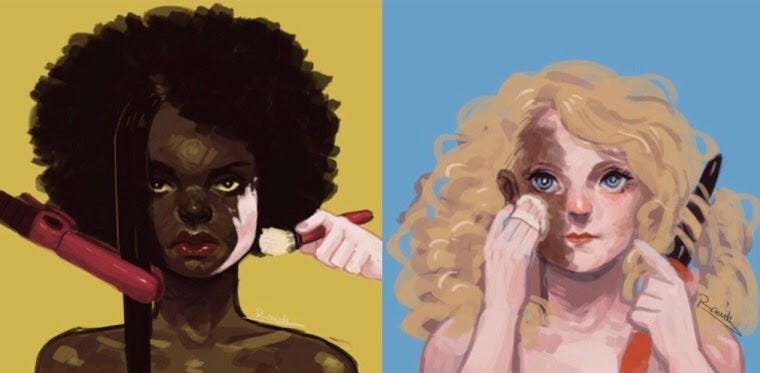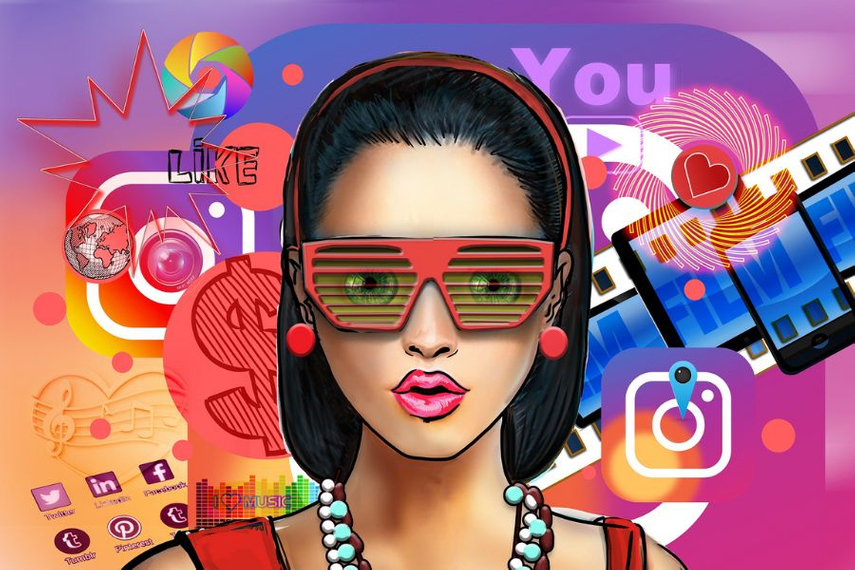Airbrushed Realities: How Influencers Are Rewriting Beauty Standards

Introduction: The Rise of the Influencer Aesthetic
In the digital age, influencers have emerged as the new arbiters of beauty, redefining traditional standards and shaping the way we perceive attractiveness. With their massive followings and meticulously curated content, influencers have become powerful tastemakers, dictating what is considered beautiful and desirable. Their influence extends far beyond the digital realm, impacting the beauty industry as a whole and changing the way brands market their products.
Influencers have become synonymous with beauty, using their platforms to showcase the latest trends, products, and techniques. Their carefully crafted content often favors a highly polished, idealized look that is both aspirational and desirable. By blending personal branding with aspirational imagery, influencers are creating a new kind of beauty narrative that is both authentic and influential.
As the beauty industry continues to evolve, influencers are at the forefront of this change, driving conversations and shaping cultural norms. With their ability to connect with millions of followers, influencers are redefining the face of beauty, making it more diverse, inclusive, and accessible than ever before. Their impact is undeniable, and their influence will only continue to grow in the years to come.
Filters, Facetune, and Fabricated Perfection
Social media platforms are flooded with images that appear effortlessly flawless, often promoted by influencers who curate their feeds to highlight an idealized version of themselves. Behind many of these posts lie a host of editing tools like filters, Facetune, and other photo-retouching apps. These digital enhancements smooth skin, slim figures, brighten eyes, and erase so-called imperfections with just a few taps. While such tools can be fun and creative, they contribute to a culture of fabricated perfection that distorts reality.
Influencers play a significant role in this phenomenon, as their carefully crafted images set unattainable beauty standards for audiences who may not realize how heavily altered these visuals are. The line between real and edited becomes increasingly blurred, leading many, especially young people, to compare themselves to these digital illusions. This comparison can fuel insecurity and dissatisfaction with their natural appearance, perpetuating a cycle of self-criticism and unrealistic expectations.
The Pressure to Perform Beauty
As the influencer culture continues to permeate social media platforms, the concept of beauty has evolved into a highly choreographed performance rather than an authentic expression of self. Influencers, who wield significant power over trends and perceptions, are often under constant scrutiny to uphold an idealized version of beauty that includes not just physical appearance but also curated lifestyles. They meticulously craft their images through filters, makeup, and strategic lighting, setting benchmarks that many followers feel compelled to emulate. This dynamic creates an environment where beauty becomes synonymous with perfection, pushing individuals to invest excessive time and resources to fit a mold that is frequently unrealistic and unattainable.
This relentless pursuit of conformity to these external standards can have detrimental effects on self-esteem and mental health. Many individuals find themselves caught in a cycle of comparison, constantly measuring their worth against the polished representations they see online. As the pressure mounts to achieve similar looks and lifestyles, the joy of personal expression often gets overshadowed by self-doubt and anxiety. The obsession with maintaining a flawless appearance can lead to burnout, as the effort to keep up with trends becomes a full-time job in itself. Thus, beauty transforms from a celebration of individuality into a performance dictated by ever-shifting, often harsh standards, leaving little room for authenticity and self-acceptance.

Changing the Face of Diversity
Diversity is no longer just a buzzword—it’s a transformative force reshaping industries, communities, and cultural landscapes. As society evolves, so too does our understanding of what true inclusivity means. Today, changing the face of diversity involves moving beyond surface-level representation to embrace a more holistic approach that includes diverse voices, experiences, and perspectives. From boardrooms and classrooms to media and technology, people from historically marginalized backgrounds are claiming space and influencing decisions in ways that challenge outdated norms. This shift not only promotes equity but also drives innovation, empathy, and resilience in an increasingly interconnected world.
The Mental Health Toll
In the age of social media, influencers wield enormous power in shaping beauty standards, often promoting unrealistic ideals that are heavily filtered, edited, or surgically enhanced. While their curated images may set trends and drive consumer behavior, they also contribute to a distorted sense of self-worth among followers, particularly young people.
Constant exposure to these idealized portrayals can lead to body dissatisfaction, anxiety, and depression, as individuals feel pressured to meet unattainable standards. The mental health toll is significant, with studies showing links between social media use and increased rates of low self-esteem and disordered eating. As the line between authenticity and performance blurs, there’s an urgent need to foster more transparent and diverse representations of beauty that support, rather than harm, mental well-being.
Authenticity as a Trend
As beauty standards continue to change, an increasing number of influencers are championing authenticity as a compelling response to the obsession with perfection. Rather than showcasing flawless makeup and airbrushed skin, many influencers are sharing unfiltered images, personal challenges, and behind-the-scenes glimpses of their lives. This movement toward transparency resonates with audiences who are growing weary of unattainable ideals and the pressure they create.
While some critics suggest that “authenticity” has become just another curated aesthetic, the broader trend among influencers signifies a refreshing shift. This new era prioritizes self-acceptance, vulnerability, and realness over artificial perfection. The most impactful voices today are those influencers who embrace imperfection, challenging the very standards they once helped to establish and encouraging others to do the same.

Beauty Standards in the Algorithm Era
In the era of algorithms, beauty standards are no longer shaped solely by culture or celebrity—they are engineered, amplified, and reinforced by technology. Social media platforms use algorithms to promote content that generates the most engagement, often favoring specific aesthetic trends such as clear skin, slim figures, symmetrical features, and Eurocentric ideals. This focus on certain attributes is heavily influenced by popular influencers, who often set these trends through their curated posts and collaborations. As a result, users are frequently exposed to a narrow and homogenized vision of beauty, which is repeatedly presented through feeds designed to capture attention.
This algorithmic feedback loop not only distorts what is considered “normal” or “attractive” but also pressures both creators and consumers, including influencers, to conform to these ideals to be noticed. The challenge now is to disrupt this cycle by promoting diversity in what is amplified, advocating for inclusive algorithms, and empowering users to define beauty on their own terms.
The Commercial Side of Beauty
The beauty industry has long been fueled by commerce, but in today’s digital age, its commercial influence is more pervasive and personalized than ever. With influencers as brand ambassadors, targeted ads, and viral product trends, beauty is no longer just about self-expression—it’s a multi-billion-dollar marketplace. From skincare routines to makeup hauls, content is often crafted with sponsorships and affiliate links in mind, blurring the line between genuine recommendations and strategic marketing. This commodification of beauty can reinforce the idea that looking good requires constant consumption, driving individuals to spend in pursuit of perfection. As consumers become more aware of these tactics, there’s growing demand for transparency, ethical practices, and products that celebrate rather than exploit individual differences.
Conclusion: Towards a More Inclusive Future
As we look to the future, it’s clear that the beauty industry is on the cusp of a revolution. The growing wave of influencers pushing for inclusivity and representation is not just a trend, but a movement towards a more equitable and empowering definition of beauty. By celebrating individuality, diversity, and confidence, these influencers are reshaping the narrative and breaking down barriers that once excluded many from the beauty conversation.
The impact of this movement extends far beyond the beauty industry itself, reflecting a broader shift in societal values. As influencers use their platforms to spotlight underrepresented communities and challenge narrow standards, they’re helping to create a more inclusive and accepting culture. This is not just about beauty; it’s about identity, self-expression, and the freedom to be oneself without apology.
Ultimately, the future of beauty is about embracing our unique qualities and celebrating the diversity that makes us human. As influencers continue to push the boundaries of what’s considered beautiful, we can expect to see a more inclusive and representative industry that reflects the complexity and richness of human experience. By joining this movement, we can create a world where everyone can feel seen, heard, and beautiful.
- RIYA SINGH
MUST READ: The Silent Divide: How Explosive Language Disputes Are Putting India’s Diversity to the Test

